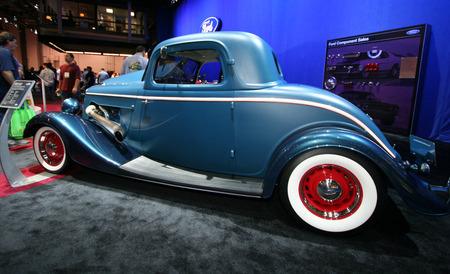Aiming to disprove the old saw that there’s no replacement for displacement, Ford has dropped its twin-turbocharged and direct-injected 3.5-liter EcoBoost V-6 into a SEMA-bound 1934 Ford three-window coupe. With the help of Detroit Street Rods and Experi-metal, the EcoBoost was reconfigured for rear-wheel-drive, mated to a five-speed manual Tremec transmission, and fitted into the replica ’34 body. Ford says this six is squeezing out an estimated 400 hp and 400 lb-ft of torque.
The power figures certainly rival those of a small-displacement V-8, and it’s easy to see that Ford is trying to get the attention of the enthusiast community with this particular build. While this marks the first rear-wheel-drive application of an EcoBoost engine, Ford wouldn’t spend the bucks to make a longitudinal installation work unless it had larger plans. And so the company reveals that the F-150 will be the first rear-drive production vehicle to be EcoBoosted, receiving the six next year. Ford also will be rolling out four-cylinder EcoBoost engines—the Australian Falcon will be the first rear-driver to get one of those, a 2.0-liter in 2011—effectively dropping two cylinders from each motor in its current lineup in favor of the turbocharged technology.
We’re not sure what kind of performance could be had with this rod, but consider the fact that the Taurus SHO we tested with the EcoBoost V-6 had 365 hp and weighed in at over 4300 pounds, yet still managed a 13.7-second run in the quarter-mile. While that’s no record-breaking ET, it’s also not slow, and this three-window probably weighs half as much as the SHO and has 35-ish more horses. Yes, it will be fast.
No word yet on how EcoBoost technology will transfer over to sportier offerings such as the Mustang. Purists would certainly be up in arms if a turbo six were to replace the V-8, regardless of how much sense it might make, so a boosted six would likely become the middle option in a three-engine lineup. Another scenario is a four-cylinder EcoBoost replacing the Stang’s lackluster and outdated 4.0-liter V-6. In any event, gains in both power and (hopefully) efficiency make everyone happy, so we’re interested to see where Ford ends up installing these engines.
View Photos
View Photos


Leave a Reply